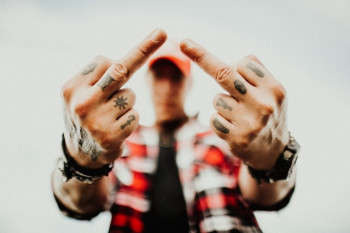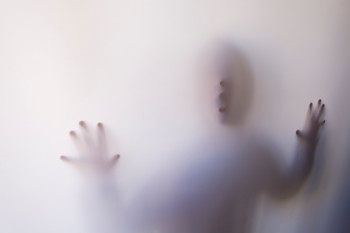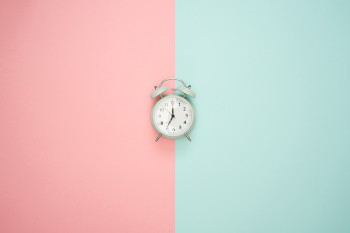© Pint of Science, 2025. All rights reserved.
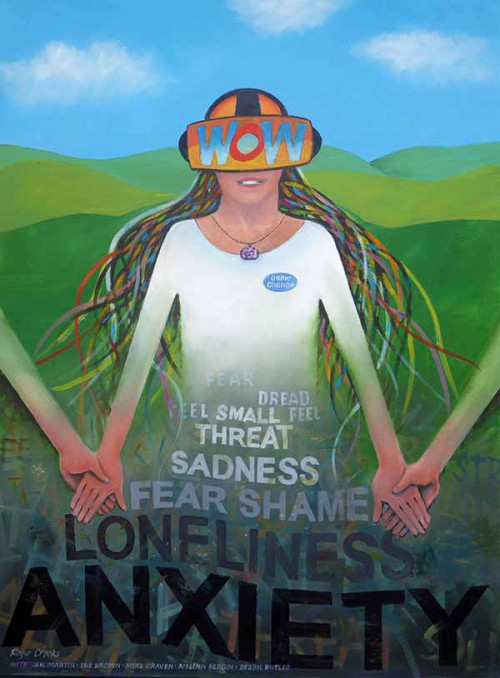
Learning to Fly. Oil on canvas, 85cm x 100cm
About the artwork
Learning to Fly (Roger Crooks) is an oil painting prepared as part of Creative Reactions 2019, in collaboration with Dr Jen Martin and the MindTech GameChange team. It was based on the work of GameChange, a project aiming to design and develop Virtual Reality treatment for people who suffer from psychosis.
The painting illustrates the journey from fear and anxiety to a better place through the use of technology (VR). This journey is shown by the patient’s feelings written in capital letters, with the WOW an intended outcome as the subject looks forward to a better life. Fundamental for the progress of this treatment is human support, represented by the holding of hands in the foreground if the painting. The landscape and cable-like hair of the patient is deliberately unnatural, symbolizing an existence in virtual reality, whilst the amethyst necklace represents the protection from fear enabled by treatment.
Getting to know Roger Crooks
Are there specific materials, contexts in which you make your work?
I work with a variety of mediums – oils, acrylics, watercolour, pastels but prefer to work on canvas. At home, I like to work with music but at the Society we tend to work in silence. The tea breaks are very noisy and lively.
Where do you find inspiration?
Everywhere – inspiration seems to come best with emotional involvement, whether excitement, happiness or sadness.
How did you start making art?
Art has been with me all of my life – after Art School I was a graphic designer but on the day I retired I joined the Nottingham Society of Artists where I now run one of the life painting groups.
Can you think of a specific story or event over the years that boosted your creativity?
This story gives my age away! - In 1969, I stayed up all night to watch on television, the first fuzzy pictures from the moon landing by the crew of Apollo 11. I was totally enthralled and the next day began work on a painting ‘Shadow on the Moon’. The painting then remained in storage for over 40 years when I retrieved and ‘restored’ it. It is now on loan and displayed at Isaac Newton’s birthplace, Woolsthorpe Manor in Lincolnshire.
Did you ever encounter any obstacles regarding your work, and how did you manage to overcome them?
Obstacles pop up every day – usually to do with frustration at my lack of skill or inability to paint what I envisage. Stubbornness helps.
Can you describe the collaboration with your scientist – did you meet, email, speak online? What did you talk about?
The collaboration with Dr Jen Martin and her team was always a delight. They were very interested and eager to contribute ideas. We met 3 or 4 times at the University and at the end of the event, I was pleased to give the painting to them to display within their department.
Was there anything that surprised you during your collaboration?
I was surprised by how many coffee shops the University supports!
How did Covid-19 affect how you could work on this and other projects?
Covid-19 put paid to this year’s collaboration and I never got to meet my scientist. It also put paid to working at the Society’s studio on Friar Lane but luckily I have my own studio in the garden which enables me to avoid some of the worst effects of Lockdown. For my Society group, I have been running an online weekly challenge so that they can keep in touch with art. I put all their contributions up on Google Photobook which now has 300-plus submissions.
Were you interested in science before participating in Creative Reactions?
Yes, I wanted to be an astronaut. On a previous Creative Reactions event I was partnered with a Particle Physicist (Tony Padillo) and greatly enjoyed our collaboration.
How would you describe the benefits of collaborations between art and science?
It worked for me. I still talk about my experiences with friends and was inspired to collaborate with a local U3A science group of nearly 30 people which led to another painting called ‘Event Horizon’. This was exhibited at the Friar Lane Gallery to which the U3A group were all invited. This was a very positive outcome which I remember with a smile.
Find out more on Roger's website.
Recent work from Roger Crooks
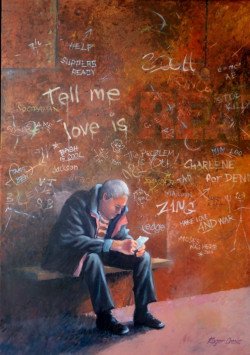 |
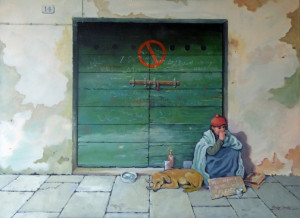 |
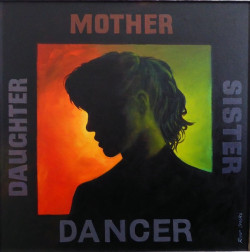 |
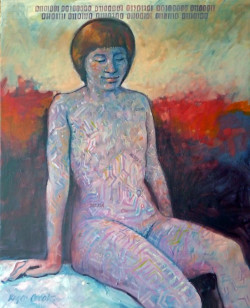 |
About this post
This blog post is part of the Creative Reactions Nottingham 2020 online exhibition. Over the month of September, we will be bringing you different examples of collaborations between art and science, including a chance to get creative yourself. More Creative Reactions Nottingham blog posts.
